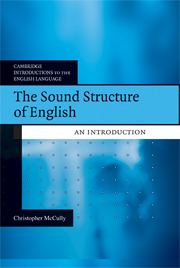Book contents
- Frontmatter
- Contents
- List of figures
- Acknowledgements
- A note on using this book
- 1 Introduction
- 2 Consonants (1): contrastiveness
- 3 Consonants (2): classification
- 4 Consonants (3): distribution
- 5 Syllables (1): introduction
- 6 Syllables (2): constituents
- 7 Syllables (3): structure
- 8 Vowels (1): short vowels
- 9 Vowels (2): long vowels and diphthongs
- 10 Vowels (3): variation
- 11 Problems, theories and representations
- Appendix: the IPA chart
- Glossary
- References
- Index of topics
- References
11 - Problems, theories and representations
Published online by Cambridge University Press: 05 June 2012
- Frontmatter
- Contents
- List of figures
- Acknowledgements
- A note on using this book
- 1 Introduction
- 2 Consonants (1): contrastiveness
- 3 Consonants (2): classification
- 4 Consonants (3): distribution
- 5 Syllables (1): introduction
- 6 Syllables (2): constituents
- 7 Syllables (3): structure
- 8 Vowels (1): short vowels
- 9 Vowels (2): long vowels and diphthongs
- 10 Vowels (3): variation
- 11 Problems, theories and representations
- Appendix: the IPA chart
- Glossary
- References
- Index of topics
- References
Summary
In this chapter…
In the last chapter we began to see that phonemes (which from another, and quite proper, point of view should be regarded as the smallest meaningful units of speech) can be conceived as expressions of their sum of distinctive features. So far in this book we've hinted at the existence of three such features – [voice], [long] and [tense] – but we've not yet done any systematic, thorough work on what a feature inventory might be. How many features are there? How do they work? How, if at all, are they patterned? How can they help us make our analyses more cogent, economical and elegant? Part of chapter 11 (11.1–11.2), therefore, is devoted to looking at distinctive features in more detail. At the same time, such detail can serve as an introduction to distinctive feature theory – a theory from which many more advanced textbooks start, and of which some prior knowledge is often assumed (see e.g. Durand 1990, Harris 1994 among many others). This theory is sometimes called classical generative phonology. (I'm using the adjective ‘classical’ here to distinguish the brand of phonology which developed distinctive features from later kinds of phonology that also have a claim to be called ‘generative’.) Such a theory, based on work accomplished in the second half of the last century, has remained very influential, and in 11.3 in particular we examine some of the theory's apparent strengths as these apply to basic issues of syllable structure.
- Type
- Chapter
- Information
- The Sound Structure of EnglishAn Introduction, pp. 180 - 211Publisher: Cambridge University PressPrint publication year: 2009

